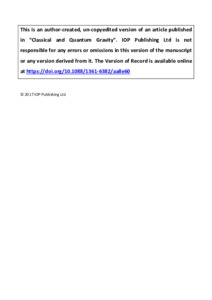Vazza, Franco ; Bruggen, Marcusi ; Gheller, Claudio ; Hackstein, Stefan ; Wittor, Denis ; Hinz, Paul
(2017)
Simulations of extragalactic magnetic fields and of their observables.
Classical and Quantum Gravity, 34
(23).
ISSN 1361-6382
Full text disponibile come:
![[thumbnail of Articolo in Rivista]](https://amsacta.unibo.it/5817/1.hassmallThumbnailVersion/5817_Vazza_et_al_2017_IOP.pdf)  Anteprima |
Documento di testo(pdf) (Articolo in Rivista)
Licenza: Salvo eventuali più ampie autorizzazioni dell'autore, il contributo può essere liberamente consultato e può essere effettuato il salvataggio e la stampa di una copia per fini strettamente personali di studio, di ricerca e di insegnamento, con espresso divieto di qualunque utilizzo direttamente o indirettamente commerciale. Ogni altro diritto sul materiale è riservato.
Download (9MB)
| Anteprima
|
Abstract
The origin of extragalactic magnetic fields is still poorly understood. Based on a dedicated suite of cosmological magneto-hydrodynamical simulations with the ENZO code we have performed a survey of different models that may have caused present-day magnetic fields in galaxies and galaxy clusters. The outcomes of these models differ in cluster outskirts, filaments, sheets and voids and we use these simulations to find observational signatures of magnetogenesis. With these simulations, we predict the signal of extragalactic magnetic fields in radio observations of synchrotron emission from the cosmic web, in Faraday rotation, in the propagation of ultra high energy cosmic rays, in the polarized signal from fast radio bursts at cosmological distance and in spectra of distant blazars. In general, primordial scenarios in which present-day magnetic fields originate from the amplification of weak (⩽nG ) uniform seed fields result in more homogeneous and relatively easier to observe magnetic fields than astrophysical scenarios, in which present-day fields are the product of feedback processes triggered by stars and active galaxies. In the near future the best evidence for the origin of cosmic magnetic fields will most likely come from a combination of synchrotron emission and Faraday rotation observed at the periphery of large-scale structures.
Abstract
The origin of extragalactic magnetic fields is still poorly understood. Based on a dedicated suite of cosmological magneto-hydrodynamical simulations with the ENZO code we have performed a survey of different models that may have caused present-day magnetic fields in galaxies and galaxy clusters. The outcomes of these models differ in cluster outskirts, filaments, sheets and voids and we use these simulations to find observational signatures of magnetogenesis. With these simulations, we predict the signal of extragalactic magnetic fields in radio observations of synchrotron emission from the cosmic web, in Faraday rotation, in the propagation of ultra high energy cosmic rays, in the polarized signal from fast radio bursts at cosmological distance and in spectra of distant blazars. In general, primordial scenarios in which present-day magnetic fields originate from the amplification of weak (⩽nG ) uniform seed fields result in more homogeneous and relatively easier to observe magnetic fields than astrophysical scenarios, in which present-day fields are the product of feedback processes triggered by stars and active galaxies. In the near future the best evidence for the origin of cosmic magnetic fields will most likely come from a combination of synchrotron emission and Faraday rotation observed at the periphery of large-scale structures.
Tipologia del documento
Articolo
Autori
Settori scientifico-disciplinari
ISSN
1361-6382
DOI
Data di deposito
11 Apr 2018 07:30
Ultima modifica
07 Nov 2018 22:00
Nome del Progetto
Programma di finanziamento
EC - H2020
URI
Altri metadati
Tipologia del documento
Articolo
Autori
Settori scientifico-disciplinari
ISSN
1361-6382
DOI
Data di deposito
11 Apr 2018 07:30
Ultima modifica
07 Nov 2018 22:00
Nome del Progetto
Programma di finanziamento
EC - H2020
URI
Statistica sui download
Statistica sui download
Gestione del documento:



 Login per gli autori
Login per gli autori



